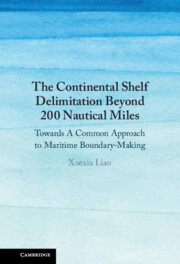 The Continental Shelf Delimitation Beyond 200 Nautical Miles
The Continental Shelf Delimitation Beyond 200 Nautical Miles Book contents
- The Continental Shelf Delimitation Beyond 200 Nautical Miles
- The Continental Shelf Delimitation Beyond 200 Nautical Miles
- Copyright page
- Contents
- Figures
- Table of Cases
- Table of Treaties
- Foreword
- Preface
- Abbreviations
- 1 Legal Uncertainties in the Continental Shelf Delimitation beyond 200 NM
- Part I Overlapping Entitlements to the Continental Shelf beyond 200 Nautical Miles
- Part II Delimitation Methodology for the Continental Shelf beyond 200 Nautical Miles
- 5 Conceptual Framework of Delimitation Methodology
- 6 Determination of the Area of Overlapping Entitlements
- 7 Geomorphological and Geological Circumstances
- 8 Geographical Circumstances
- 9 Towards a Common Approach to Maritime Delimitation within and beyond 200 NM
- Book part
- Bibliography
- Index
9 - Towards a Common Approach to Maritime Delimitation within and beyond 200 NM
from Part II - Delimitation Methodology for the Continental Shelf beyond 200 Nautical Miles
Published online by Cambridge University Press: 08 October 2021
- The Continental Shelf Delimitation Beyond 200 Nautical Miles
- The Continental Shelf Delimitation Beyond 200 Nautical Miles
- Copyright page
- Contents
- Figures
- Table of Cases
- Table of Treaties
- Foreword
- Preface
- Abbreviations
- 1 Legal Uncertainties in the Continental Shelf Delimitation beyond 200 NM
- Part I Overlapping Entitlements to the Continental Shelf beyond 200 Nautical Miles
- Part II Delimitation Methodology for the Continental Shelf beyond 200 Nautical Miles
- 5 Conceptual Framework of Delimitation Methodology
- 6 Determination of the Area of Overlapping Entitlements
- 7 Geomorphological and Geological Circumstances
- 8 Geographical Circumstances
- 9 Towards a Common Approach to Maritime Delimitation within and beyond 200 NM
- Book part
- Bibliography
- Index
Summary
This chapter explores a broader question with respect to the delimitation methodology for the continental shelf beyond 200 nautical miles, namely, whether an equitable solution for the continental shelf differs from that for an exclusive economic zone. Examining resources-related circumstances, conduct of the parties, and special characteristics of the maritime zones, this chapter argues that a court or tribunal hardly resorts to regime-specific circumstances in maritime delimitation, because maritime delimitation is a spatial exercise that spells out the relationship between the relevant coasts and the maritime areas. It thus concludes, on the basis of the State practice and the jurisprudence that witnesses a trend towards a single exercise of maritime delimitation, the law of maritime delimitation will develop to embrace a common approach to maritime delimitation within and beyond 200 nm.
Keywords
- Type
- Chapter
- Information
- The Continental Shelf Delimitation Beyond 200 Nautical MilesTowards A Common Approach to Maritime Boundary-Making, pp. 301 - 330Publisher: Cambridge University PressPrint publication year: 2021


